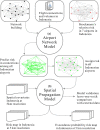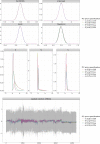Mapping ex ante risks of COVID-19 in Indonesia using a Bayesian geostatistical model on airport network data
- PMID: 35942194
- PMCID: PMC9350309
- DOI: 10.1111/rssa.12866
Mapping ex ante risks of COVID-19 in Indonesia using a Bayesian geostatistical model on airport network data
Abstract
A rapid response to global infectious disease outbreaks is crucial to protect public health. Ex ante information on the spatial probability distribution of early infections can guide governments to better target protection efforts. We propose a two-stage statistical approach to spatially map the ex ante importation risk of COVID-19 and its uncertainty across Indonesia based on a minimal set of routinely available input data related to the Indonesian flight network, traffic and population data, and geographical information. In a first step, we use a generalised additive model to predict the ex ante COVID-19 risk for 78 domestic Indonesian airports based on data from a global model on the disease spread and covariates associated with Indonesian airport network flight data prior to the global COVID-19 outbreak. In a second step, we apply a Bayesian geostatistical model to propagate the estimated COVID-19 risk from the airports to all of Indonesia using freely available spatial covariates including traffic density, population and two spatial distance metrics. The results of our analysis are illustrated using exceedance probability surface maps, which provide policy-relevant information accounting for the uncertainty of the estimates on the location of areas at risk and those that might require further data collection.
Keywords: Bayesian geostatistics; COVID‐19; INLA‐SPDE; Indonesia; disease mapping; network analysis.
© 2022 The Authors. Journal of the Royal Statistical Society: Series A (Statistics in Society) published by John Wiley & Sons Ltd on behalf of Royal Statistical Society.
Figures















Similar articles
-
Bayesian spatial modelling of geostatistical data using INLA and SPDE methods: A case study predicting malaria risk in Mozambique.Spat Spatiotemporal Epidemiol. 2021 Nov;39:100440. doi: 10.1016/j.sste.2021.100440. Epub 2021 Aug 3. Spat Spatiotemporal Epidemiol. 2021. PMID: 34774255
-
Mapping the prevalence of severe acute malnutrition in Papua, Indonesia by using geostatistical models.BMC Nutr. 2022 Feb 14;8(1):13. doi: 10.1186/s40795-022-00504-z. BMC Nutr. 2022. PMID: 35152906 Free PMC article.
-
Quantitative method for resilience assessment framework of airport network during COVID-19.PLoS One. 2021 Dec 3;16(12):e0260940. doi: 10.1371/journal.pone.0260940. eCollection 2021. PLoS One. 2021. PMID: 34860845 Free PMC article.
-
Statistical methodological issues in mapping historical schistosomiasis survey data.Acta Trop. 2013 Nov;128(2):345-52. doi: 10.1016/j.actatropica.2013.04.012. Epub 2013 May 3. Acta Trop. 2013. PMID: 23648217 Review.
-
Universal screening for SARS-CoV-2 infection: a rapid review.Cochrane Database Syst Rev. 2020 Sep 15;9(9):CD013718. doi: 10.1002/14651858.CD013718. Cochrane Database Syst Rev. 2020. PMID: 33502003 Free PMC article.
References
-
- Ahlawat, A. , Wiedensohler, A. & Mishra, S.K. (2020) An overview on the role of relative humidity in airborne transmission of SARS‐CoV‐2 in indoor environments. Aerosol and Air Quality Research, 20, 1856–1861.
-
- aviationstack . (2020) Free, Real‐time Flight Status and Global Aviation Data API. [Accessed 10 January 2021] Available from: https://www.aviationstack.com
-
- Bakka, H. , Rue, H. , Fuglstad, G. , Riebler, A. , Bolin, D. , Illian, J. et al. (2018) Spatial modeling with R–INLA: a review. Wiley Interdisciplinary Reviews: Computational Statistics, 10, e1443.
LinkOut - more resources
Full Text Sources
